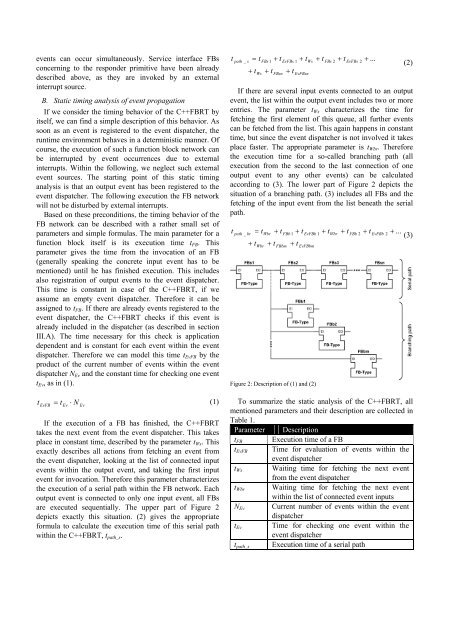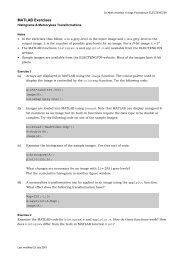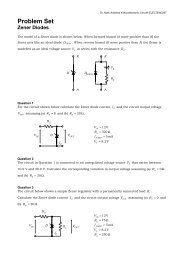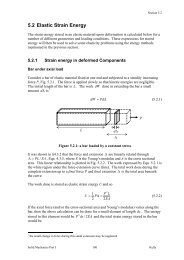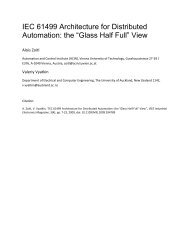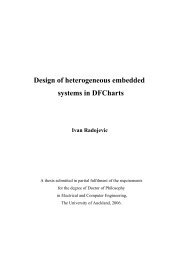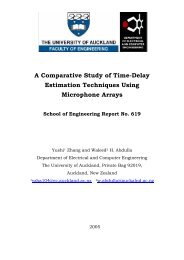Formal description of IEC 61499 control logic with - The University of ...
Formal description of IEC 61499 control logic with - The University of ...
Formal description of IEC 61499 control logic with - The University of ...
You also want an ePaper? Increase the reach of your titles
YUMPU automatically turns print PDFs into web optimized ePapers that Google loves.
events can occur simultaneously. Service interface FBs<br />
concerning to the responder primitive have been already<br />
described above, as they are invoked by an external<br />
interrupt source.<br />
B. Static timing analysis <strong>of</strong> event propagation<br />
If we consider the timing behavior <strong>of</strong> the C++FBRT by<br />
itself, we can find a simple <strong>description</strong> <strong>of</strong> this behavior. As<br />
soon as an event is registered to the event dispatcher, the<br />
runtime environment behaves in a deterministic manner. Of<br />
course, the execution <strong>of</strong> such a function block network can<br />
be interrupted by event occurrences due to external<br />
interrupts. Within the following, we neglect such external<br />
event sources. <strong>The</strong> starting point <strong>of</strong> this static timing<br />
analysis is that an output event has been registered to the<br />
event dispatcher. <strong>The</strong> following execution the FB network<br />
will not be disturbed by external interrupts.<br />
Based on these preconditions, the timing behavior <strong>of</strong> the<br />
FB network can be described <strong>with</strong> a rather small set <strong>of</strong><br />
parameters and simple formulas. <strong>The</strong> main parameter for a<br />
function block itself is its execution time tFB. This<br />
parameter gives the time from the invocation <strong>of</strong> an FB<br />
(generally speaking the concrete input event has to be<br />
mentioned) until he has finished execution. This includes<br />
also registration <strong>of</strong> output events to the event dispatcher.<br />
This time is constant in case <strong>of</strong> the C++FBRT, if we<br />
assume an empty event dispatcher. <strong>The</strong>refore it can be<br />
assigned to tFB. If there are already events registered to the<br />
event dispatcher, the C++FBRT checks if this event is<br />
already included in the dispatcher (as described in section<br />
III.A). <strong>The</strong> time necessary for this check is application<br />
dependent and is constant for each event <strong>with</strong>in the event<br />
dispatcher. <strong>The</strong>refore we can model this time tEvFB by the<br />
product <strong>of</strong> the current number <strong>of</strong> events <strong>with</strong>in the event<br />
dispatcher NEv and the constant time for checking one event<br />
tEv, as in (1).<br />
t = t ⋅ N<br />
(1)<br />
EvFB<br />
Ev<br />
Ev<br />
If the execution <strong>of</strong> a FB has finished, the C++FBRT<br />
takes the next event from the event dispatcher. This takes<br />
place in constant time, described by the parameter tWs. This<br />
exactly describes all actions from fetching an event from<br />
the event dispatcher, looking at the list <strong>of</strong> connected input<br />
events <strong>with</strong>in the output event, and taking the first input<br />
event for invocation. <strong>The</strong>refore this parameter characterizes<br />
the execution <strong>of</strong> a serial path <strong>with</strong>in the FB network. Each<br />
output event is connected to only one input event, all FBs<br />
are executed sequentially. <strong>The</strong> upper part <strong>of</strong> Figure 2<br />
depicts exactly this situation. (2) gives the appropriate<br />
formula to calculate the execution time <strong>of</strong> this serial path<br />
<strong>with</strong>in the C++FBRT, tpath_s.<br />
t<br />
= t + t + t + t + t + ...<br />
path _ s FBs 1 EvFBs 1 Ws FBs 2 EvFBs 2<br />
(2)<br />
+ t<br />
Ws<br />
+ t<br />
FBsn<br />
+ t<br />
EvFBsn<br />
If there are several input events connected to an output<br />
event, the list <strong>with</strong>in the output event includes two or more<br />
entries. <strong>The</strong> parameter tWs characterizes the time for<br />
fetching the first element <strong>of</strong> this queue, all further events<br />
can be fetched from the list. This again happens in constant<br />
time, but since the event dispatcher is not involved it takes<br />
place faster. <strong>The</strong> appropriate parameter is tWbr. <strong>The</strong>refore<br />
the execution time for a so-called branching path (all<br />
execution from the second to the last connection <strong>of</strong> one<br />
output event to any other events) can be calculated<br />
according to (3). <strong>The</strong> lower part <strong>of</strong> Figure 2 depicts the<br />
situation <strong>of</strong> a branching path. (3) includes all FBs and the<br />
fetching <strong>of</strong> the input event from the list beneath the serial<br />
path.<br />
t<br />
path _ br Wbr FBb 1 EvFBb 1 Wbr FBb 2 EvFBb 2 (3)<br />
+ t<br />
= t + t + t + t + t + t + ...<br />
Wbr<br />
+ t<br />
FBbm<br />
+ t<br />
EvFBbm<br />
Figure 2: Description <strong>of</strong> (1) and (2)<br />
To summarize the static analysis <strong>of</strong> the C++FBRT, all<br />
mentioned parameters and their <strong>description</strong> are collected in<br />
Table 1.<br />
Parameter Description<br />
tFB Execution time <strong>of</strong> a FB<br />
tEvFB Time for evaluation <strong>of</strong> events <strong>with</strong>in the<br />
event dispatcher<br />
tWs Waiting time for fetching the next event<br />
from the event dispatcher<br />
tWbr Waiting time for fetching the next event<br />
<strong>with</strong>in the list <strong>of</strong> connected event inputs<br />
NEv Current number <strong>of</strong> events <strong>with</strong>in the event<br />
dispatcher<br />
tEv Time for checking one event <strong>with</strong>in the<br />
event dispatcher<br />
Execution time <strong>of</strong> a serial path<br />
tpath_s


